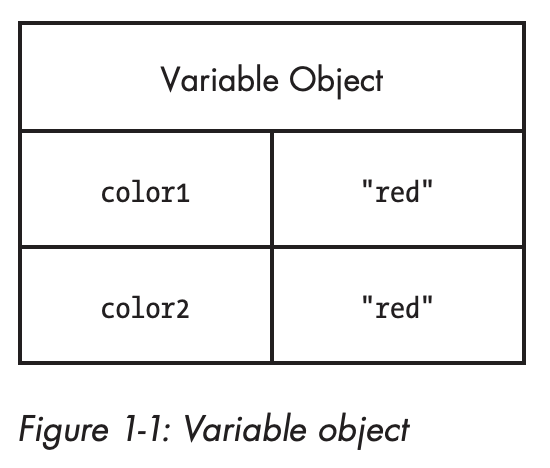Introduction
Definition#
JavaScript is high-level, often just-in-time compiled, and multi-paradigm programming language. It has curly-bracket syntax, dynamic typing, prototype-based object-orientation, and first-class functions.
As a multi-paradigm language, JavaScript supports event-driven, functional, and imperative programming styles. It has application programming interfaces (APIs) for working with text, dates, regular expressions, standard data structures, and the Document Object Model (DOM).
JavaScript is a client-side scripting language, which means the source code is processed by the client's web browser rather than on the web server.
Data Types#
There are two kinds of types in Javascript: primitive and reference. Primitive types are stored as simple data types. Reference types are stored as objects, which are really just references to locations in memory.
Primitive types#
Primitive types represent simple pieces of data that are stored as is, such as (e.g. boolean true, number 42). There are 6 primitive types in JavaScript:
- Boolean
- Number
- String
- Symbol
- Null
- Undefined
A variable holding a primitive directly contains the primitive value (rather than a pointer to an object). When you assign a primitive value to a variable, the value is copied into that variable. This means that if you set one variable equal to another, each variable gets its own copy of the data. For example:
Here, even though color1 and color2 contain the same value, they are completely separate from each other, and you can change the value in color1 without affecting color2 and vice versa. That’s because there are two different storage locations, one for each variable:

Because each variable containing a primitive value uses its own storage space, changes to one variable are not reflected on the other. You can think of the variables as having no relationship to each other. For example:
In this code, color1 is changed to "blue" and color2 retains its original value of "red".
Conclusion: If the value is a primitive type, when you access the variable, you manipulate the actual value stored in that variable. In other words, the variable that stores a primitive value is accessed by value.
Reference types#
Reference types do not store the object directly into the variable to which it is assigned, instead, it holds a pointer (or reference) to the location in memory where the object exists. This is the primary difference between objects and primitive values, as the primitive is stored directly in the variable. There are 3 main reference types in JavaScript:
- Array
- Object
- Function
When you assign an object to a variable, you’re actually assigning a pointer (reference). That means if you assign one variable to another, each variable gets a copy of the pointer, and both still reference the same object in memory. For example:
This code first creates an object and stores a reference in object1. Next, object2 is assigned the value of object1. There is still only the one instance of the object that was created on the first line, but both variables now point to that object, as illustrated in Figure 1-3.

Conclusion If the value is a reference type, when you manipulate an object, you work on the reference of that object, rather than the actual object. It means a variable that stores an object is accessed by reference.
Hoisting#
Hoisting is a JavaScript mechanism where variables and function declarations are moved to the top of their scope before code execution. In other words a variable can be used before it has been declared. For example:
important
JavaScript only hoists declarations, not initializations (assignments).
For example:
This is because only the declaration (var x), not the initialization (=5) is hoisted to the top. Because of hoisting, x has been declared before it is used, but because initializations are not hoisted, the value of x is undefined.
The let and const Keywords#
Variables defined with let and const are hoisted to the top of the block, but not initialized. Meaning: The block of code is aware of the variable, but it cannot be used until it has been declared. In other words, with let and const, you cannot use a variable before it is declared.
Using let will result in a ReferenceError:
Using a const variable before it is declared, is a syntax error, so the code will simply not run:
Closures#
JavaScript variables can belong to the local or global scope. Global variables can be made local (private) with closures. For example:
Example Explained#
The variable add is assigned to the return value of a self-invoking function. The self-invoking function only runs once. It sets the counter to zero (0), and returns a function expression. The most important part is that inner function can access to the outer function's (its parent scope) "counter" variable. This is called a JavaScript closure. It makes it possible for a function to have local (private) variables. The "counter" variable is protected by the scope of the anonymous function, and can only be changed using the add function.
Conclusion A closure is a feature in JavaScript where an inner function has access to the outer (enclosing) function’s variables — a scope chain. The closure has three scope chains:
- It has access to its own scope — variables defined between its curly brackets.
- It has access to the outer function’s variables.
- It has access to the global variables.